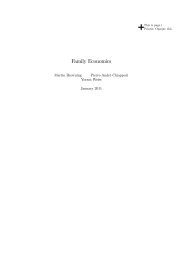The relationship between DSGE and VAR models - cemmap
The relationship between DSGE and VAR models - cemmap
The relationship between DSGE and VAR models - cemmap
You also want an ePaper? Increase the reach of your titles
YUMPU automatically turns print PDFs into web optimized ePapers that Google loves.
emplied by Rotemberg <strong>and</strong> Woodford (1998), who tweaked the timing in their <strong>DSGE</strong> model<br />
to make it conform with their structural <strong>VAR</strong> model.<br />
Consolo, Favero <strong>and</strong> Paccagnini (2009) add to the discussion on the suitability of reduced<br />
form <strong>VAR</strong> as benchmarks for evaluating <strong>DSGE</strong> <strong>models</strong> by resorting to the notion of statistical<br />
identication (Spanos, 1990). Spanos (1990) advocates validating structural <strong>models</strong> using<br />
reduced form <strong>models</strong> that are themselves valid, in the sense that they pass a battery of tests.<br />
Consolo et al. (2009) point out that in the literature on <strong>DSGE</strong> validation, instead, the choice<br />
of the reduced form model is solely driven by that of the structural model, without considerations<br />
about how accurately the reduced form model describes the data. <strong>The</strong> critique is applied<br />
in particular to the model evaluation approach of Del Negro <strong>and</strong> Schorfheide (2004, 2006),<br />
who obtain the reduced form model by relaxing the cross-equation restrictions imposed by the<br />
<strong>DSGE</strong>, but the point Consolo et al. (2009) make is relevant in our discussion as well. If the<br />
mapping <strong>between</strong> <strong>DSGE</strong> <strong>and</strong> <strong>VAR</strong> is done in the rigorous way mapped out in this chapter,<br />
the benchmark <strong>VAR</strong> will be low-dimensional, it will omit potentially relevant variables, it will<br />
not have time-varying parameters, <strong>and</strong> as a result it may not be a good representation of the<br />
data. Consolo et al. (2009) propose to overcome this limitation by comparing <strong>DSGE</strong> <strong>models</strong> to<br />
factor-agumented <strong>VAR</strong>, but the mapping from the theoretical to the reduced form model will in<br />
this case be lost <strong>and</strong> it will be difcult to underst<strong>and</strong> whether the model is rejected because of<br />
misspecied restrictions or because of omitted variables.<br />
5 What next<br />
<strong>The</strong> work of Canova (2012), Consolo et al. (2009) <strong>and</strong> Del Negro <strong>and</strong> Schorfheide (2004, 2006)<br />
share the concern that <strong>DSGE</strong> <strong>models</strong> are too stylized <strong>and</strong> that the restrictions they impose on<br />
their reduced form counterparts are too restrictive for the outcomes of their estimation <strong>and</strong><br />
validation to be taken too seriously. A more radical view is expressed by Howitt et. al (2008)<br />
<strong>and</strong> Pesaran <strong>and</strong> Smith (2011), who call for the profession to move beyond the narrow <strong>and</strong> ad<br />
hoc modelling framework of <strong>DSGE</strong> <strong>models</strong>, echoing the widely expressed concern that these<br />
<strong>models</strong> ignored important nancial, housing <strong>and</strong> foreign channels that were crucial during the<br />
19













